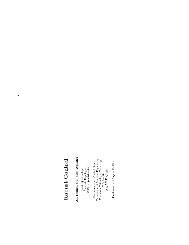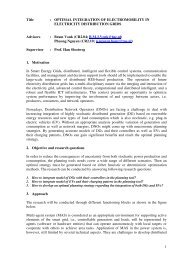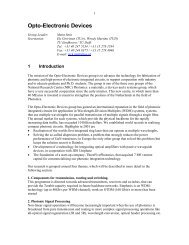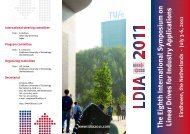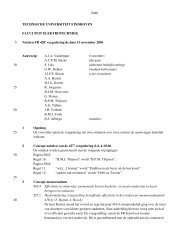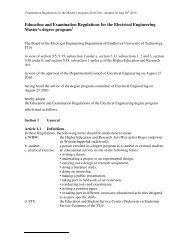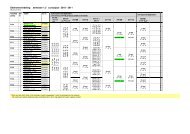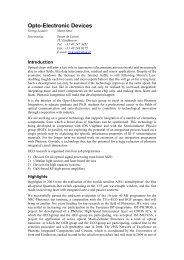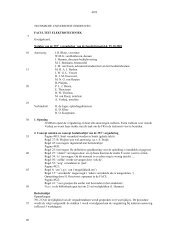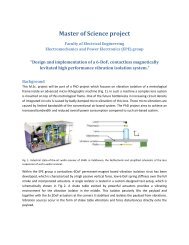on the feasibility of application of class e rf power amplifiers in umts
on the feasibility of application of class e rf power amplifiers in umts
on the feasibility of application of class e rf power amplifiers in umts
You also want an ePaper? Increase the reach of your titles
YUMPU automatically turns print PDFs into web optimized ePapers that Google loves.
used for calculati<strong>on</strong> <strong>of</strong> <strong>the</strong> ACPR are obta<strong>in</strong>ed from <strong>the</strong> results <strong>of</strong> 35<br />
<br />
transient simulati<strong>on</strong> <strong>in</strong> SpectreRF circuit simulator. The waveform<br />
<br />
calculator <strong>of</strong> Spectre RF has been used <strong>in</strong> calculati<strong>on</strong>s. In figure 7,<br />
<strong>the</strong> <strong>power</strong> spectrum <strong>of</strong> <strong>the</strong> output signal is displayed. It is impor-<br />
−10<br />
−30<br />
−50<br />
−70<br />
−90<br />
1.93<br />
Rel. <strong>power</strong> (dB)<br />
1.95<br />
1.97 f(GHz)<br />
Figure 7. Power spectral density <strong>of</strong> <strong>the</strong> output signal<br />
tant to note that all blocks <strong>in</strong> <strong>the</strong> l<strong>in</strong>earizati<strong>on</strong> schematic (multipliers,<br />
adders, square and square root functi<strong>on</strong>s) are ideal and do not <strong>in</strong>troduce<br />
any delay nor distorti<strong>on</strong>. This is <strong>of</strong> crucial importance, s<strong>in</strong>ce <strong>the</strong><br />
EER technique is particularly sensitive to delay mismatch <strong>in</strong> <strong>the</strong> envelope<br />
and phase path. The ACPR <strong>of</strong> £§ signal, generated by an<br />
ideal IQ modulator, is 65 dBc and 85 dBc, for ACPR ¡ and ACPR ,<br />
respectively. Therefore, <strong>the</strong> output signal exhibits a certa<strong>in</strong> degradati<strong>on</strong>,<br />
even though <strong>the</strong> build<strong>in</strong>g blocks <strong>in</strong> <strong>the</strong> EER circuit are ideal.<br />
Reas<strong>on</strong>s for such behaviour are multiple. First, <strong>the</strong> amplifier <strong>in</strong>troduces<br />
certa<strong>in</strong> amount <strong>of</strong> phase distorti<strong>on</strong>. Sec<strong>on</strong>dly, <strong>the</strong> assumpti<strong>on</strong><br />
that <strong>the</strong> amplitude <strong>of</strong> <strong>the</strong> output signal is l<strong>in</strong>early dependent <strong>on</strong> <strong>the</strong><br />
supply voltage does not hold <strong>in</strong> practice. Theoretically, <strong>the</strong> amplitude<br />
<strong>of</strong> <strong>the</strong> output signal from an ideal <strong>class</strong> E PA, supplied by <br />
, © <br />
is<br />
and <strong>the</strong><br />
<br />
ratio rema<strong>in</strong>s c<strong>on</strong>stant <br />
when<br />
changes [3]. This is not <strong>the</strong> case <strong>in</strong> practice, s<strong>in</strong>ce <strong>the</strong>re is <strong>the</strong><br />
entire set <strong>of</strong> voltage-dependent effects <strong>of</strong> a transistor, such as n<strong>on</strong>l<strong>in</strong>ear<br />
parasitic output capacitance. In figure 8, it is shown how <strong>the</strong><br />
amplitude <strong>of</strong> <strong>the</strong> output signal depends <strong>on</strong> <strong>the</strong> supply voltage, for <strong>the</strong><br />
PA based <strong>on</strong> <strong>the</strong> HBT. Factor is def<strong>in</strong>ed <br />
© <br />
as . It can be<br />
noticed that is smaller than <strong>the</strong> <strong>the</strong>oretical value <strong>of</strong> 1.074, which is<br />
expla<strong>in</strong>ed by <strong>the</strong> n<strong>on</strong>-idealities <strong>of</strong> a real circuit and <strong>in</strong>evitable losses.<br />
But <strong>the</strong><br />
<br />
n<strong>on</strong>-c<strong>on</strong>stant ratio is a more significant shortcom<strong>in</strong>g,<br />
s<strong>in</strong>ce it will have a direct impact <strong>on</strong> <strong>the</strong> l<strong>in</strong>earity and ACPR pe<strong>rf</strong>ormance.<br />
The PAE also changes with <strong>the</strong> supply voltage, and <strong>the</strong><br />
corresp<strong>on</strong>d<strong>in</strong>g plot for HBT based PA is given <strong>in</strong> figure 9.<br />
k 0.82<br />
0.78<br />
0.74<br />
0.7<br />
0.75<br />
1.2 1.65<br />
Figure 8. N<strong>on</strong>-c<strong>on</strong>stant<br />
PAE [%] 90<br />
80<br />
70<br />
60<br />
50<br />
40<br />
30<br />
20<br />
10<br />
2.1<br />
<br />
0.75 1.2 1.65 2.1<br />
2.55 3.0<br />
V DC [V]<br />
ratio <strong>in</strong> a <strong>class</strong> E PA<br />
2.55 3.0 VDC [V]<br />
Figure 9. PAE dependence <strong>on</strong> <strong>the</strong> supply voltage<br />
6. CONCLUSIONS<br />
In this paper results <strong>of</strong> an <strong>in</strong>vestigati<strong>on</strong> <strong>in</strong>to <strong>the</strong> <strong>class</strong> E PA capabilities<br />
for utilizati<strong>on</strong> <strong>in</strong> UMTS are presented. Class E circuits with three<br />
different active devices were designed and simulated. The results <strong>of</strong><br />
<strong>the</strong> simulati<strong>on</strong>s show that a comparable pe<strong>rf</strong>ormance is achieved with<br />
all three technologies, but <strong>the</strong> GaAs is <strong>the</strong> most promis<strong>in</strong>g opti<strong>on</strong>. A<br />
l<strong>in</strong>earizati<strong>on</strong> testbench based <strong>on</strong> <strong>the</strong> EER pr<strong>in</strong>ciple has been designed<br />
and applied, and <strong>the</strong> ACPR pe<strong>rf</strong>ormance was simulated. All three<br />
PAs exhibited pe<strong>rf</strong>ormance that satisfies <strong>the</strong> requirements prescribed<br />
by <strong>the</strong> UMTS standard. These simulati<strong>on</strong>s <strong>in</strong>dicate that <strong>class</strong> E PAs,<br />
given <strong>the</strong> appropriate signals from <strong>the</strong> l<strong>in</strong>earizati<strong>on</strong> circuitry are provided,<br />
can successfully be used for <strong>power</strong> amplificati<strong>on</strong> <strong>of</strong> WCDMA<br />
RF signal. Accord<strong>in</strong>g to our best knowledge, this is <strong>the</strong> first report<br />
<strong>in</strong> literature that quantitatively <strong>in</strong>vestigates <strong>the</strong> operati<strong>on</strong> <strong>of</strong> <strong>class</strong> E<br />
PAs for UMTS. The presented results <strong>in</strong>dicate that a fur<strong>the</strong>r <strong>in</strong>vestigati<strong>on</strong><br />
<strong>on</strong> this type <strong>of</strong> PAs and <strong>the</strong> l<strong>in</strong>earizati<strong>on</strong> circuits is <strong>of</strong> high<br />
importance. The ACPR pe<strong>rf</strong>ormance can be improved by add<strong>in</strong>g a<br />
predistorti<strong>on</strong> block <strong>in</strong> <strong>the</strong> envelope path, that would compensate <strong>the</strong><br />
n<strong>on</strong>l<strong>in</strong>earity caused by n<strong>on</strong>-c<strong>on</strong>stant factor. In practice, <strong>the</strong> n<strong>on</strong>idealities<br />
and limitati<strong>on</strong>s <strong>of</strong> <strong>the</strong> EER blocks will have negative effect <strong>on</strong><br />
<strong>the</strong> ACPR, and extensive research has to be d<strong>on</strong>e <strong>on</strong> <strong>the</strong> practical implementati<strong>on</strong>.<br />
Reduced efficiency <strong>of</strong> <strong>the</strong> <strong>class</strong> E stage at lower supply<br />
voltages <strong>in</strong>dicates that an advanced hybrid soluti<strong>on</strong> <strong>in</strong> <strong>the</strong> form <strong>of</strong> a<br />
comb<strong>in</strong>ati<strong>on</strong> <strong>of</strong> l<strong>in</strong>ear (e.g. <strong>class</strong> A) and switch<strong>in</strong>g type PA should be<br />
c<strong>on</strong>sidered, <strong>in</strong> order to obta<strong>in</strong> a satisfy<strong>in</strong>g overall efficiency pe<strong>rf</strong>ormance<br />
at all <strong>power</strong> levels.<br />
ACKNOWLEDGMENTS<br />
The work presented <strong>in</strong> this paper is funded by <strong>the</strong> Dutch technology<br />
foundati<strong>on</strong> STW. The authors would also like to thank Peter Baltus,<br />
Hans Hegt and P<strong>in</strong>g Wang for fruitful and c<strong>on</strong>structive discussi<strong>on</strong>s.<br />
7. REFERENCES<br />
[1] N. O. Sokal and A. D. Sokal, “Class E—A new <strong>class</strong> <strong>of</strong> highefficiency<br />
tuned s<strong>in</strong>gle-ended switch<strong>in</strong>g <strong>power</strong> <strong>amplifiers</strong>,”<br />
IEEE J. Solid-State Circuits, vol. SC-10, no. 6, pp. 168-176,<br />
June 1975.<br />
[2] N. O. Sokal, “Class-E switch<strong>in</strong>g-mode high-efficiency tuned<br />
RF/microwave <strong>power</strong> amplifier: improved design equati<strong>on</strong>s,”<br />
IEEE MTT-S Int. Microwave Symp. Digest, 2000, vol. 2 , pp.<br />
779-782.<br />
[3] F. H. Raab, “Idealized operati<strong>on</strong> <strong>of</strong> <strong>the</strong> <strong>class</strong> E tuned <strong>power</strong><br />
amplifier,” IEEE Transacti<strong>on</strong>s <strong>on</strong> Circuits and Systems, vol.<br />
CAS-24, no. 12, pp. 725-735, December 1977.<br />
[4] G. K. W<strong>on</strong>g and S. I. L<strong>on</strong>g, High efficiency bipolar <strong>power</strong><br />
amplifers, F<strong>in</strong>al Report 1997-98 for MICRO Project 97-104,<br />
see www.ucop.edu/research/micro/97 98/97 104.pdf<br />
[5] D. K. Choi and S. I. L<strong>on</strong>g, “A physically based analytic model<br />
<strong>of</strong> FET Class-E <strong>power</strong> <strong>amplifiers</strong>—design<strong>in</strong>g for maximum<br />
PAE,” IEEE Transacti<strong>on</strong>s <strong>on</strong> Microwave Theory and Techniques,<br />
vol. 47, no. 9, pp. 1712-1720, September 1999.<br />
[6] C. Yoo and Q. Huang, “A comm<strong>on</strong>-gate switched 0.9-W <strong>class</strong>-<br />
E <strong>power</strong> amplifier with 41 % PAE <strong>in</strong> 0.25- CMOS,” IEEE<br />
J. Solid-State Circuits, vol. 36, no. 5, pp. 823-830, May 2001.<br />
[7] S. C. Cripps, RF Power Amplifiers for Wireless Communicati<strong>on</strong>s,<br />
Artech House, 1999.



